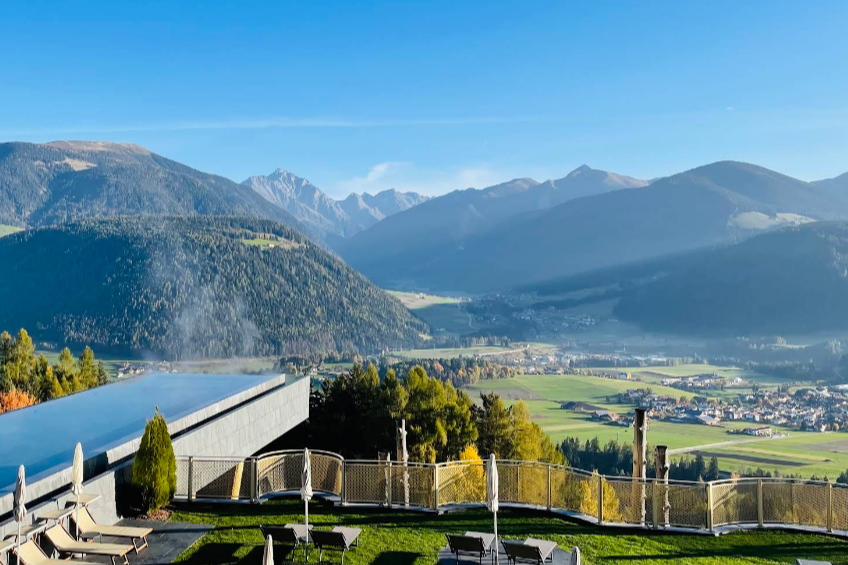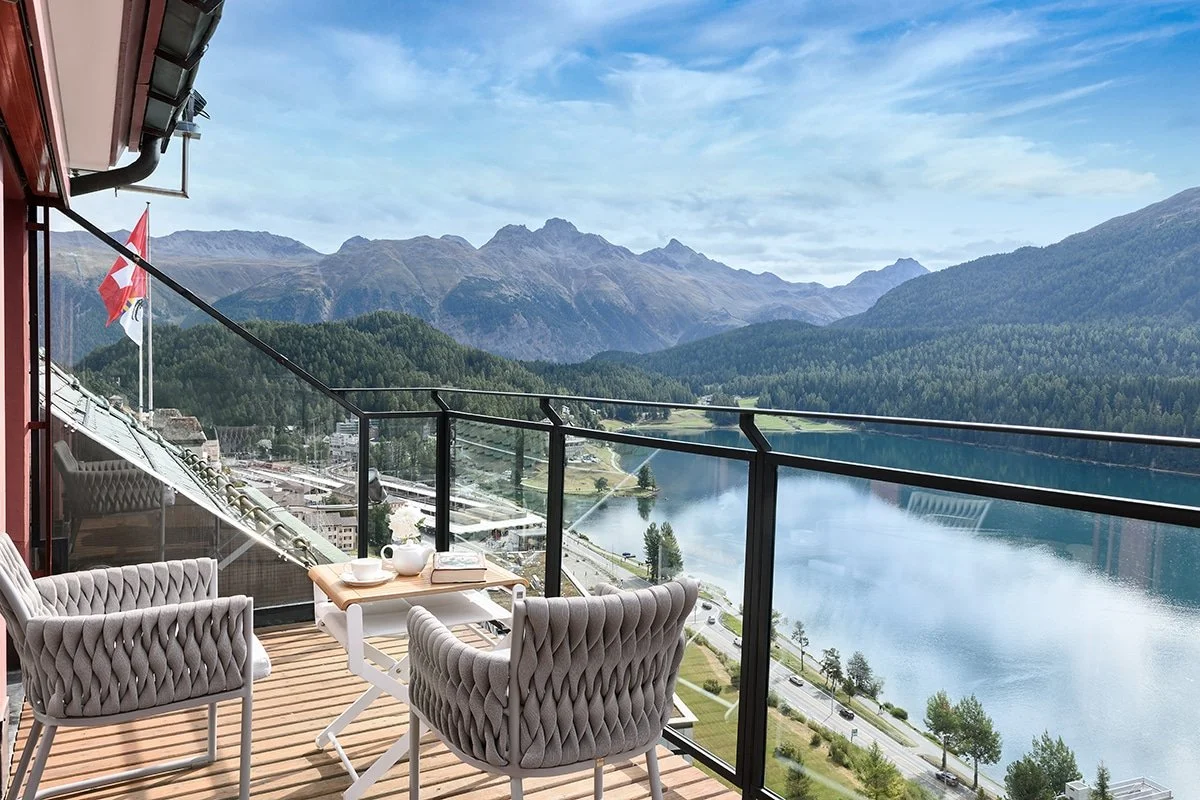Summer in the Alps: Wellness, Altitude, and Elevated Simplicity
When winter recedes, the Alps reveal a different rhythm. One defined by alpine trails, forest air, wellness rituals, and long days spent outdoors. Spanning France, Switzerland, Italy, Austria, and Germany, the region draws summer travelers looking to hike, cycle, recharge, and enjoy the clarity of mountain living. The landscape shifts from snow-covered drama to sculpted meadows, pine forests, and rugged peaks.
Whether you're seeking a structured wellness retreat or a more independent journey of exploration, the Alps in summer offer a rare combination of scale, access, and cultural nuance.
Regional Character: A Breakdown by Country
Italy: Design-Forward Retreats
Italy’s stretch of the Alps is defined by the Dolomites. Sharp, pale cliffs that shift in color with the light and form one of Europe’s most visually striking mountain landscapes. Unlike the more rounded peaks found elsewhere, the Dolomites feel sculptural and vertical, with limestone spires rising above alpine pastures. The region reflects a blend of Italian, Austrian, and Ladin influences, creating a layered cultural experience where you might hike a German-named trail in an Italian-speaking town and eat traditional Ladin dishes. The area is especially suited to travelers seeking strong design sensibility, robust culinary traditions, and a quieter pace off the main tourist path.
Where to Stay:
Forestis Dolomites is perched above the Puster Valley, with minimalist suites and a spa concept built around the four natural elements.
Aman Rosa Alpina offers discreet service and direct access to the Alta Badia network of trails and via ferratas.
Alpin Panorama Hotel Hubertus is known for its cantilevered Sky Pool and comprehensive alpine activity programming.
San Luis Retreat Hotel & Lodges features standalone wooden chalets surrounding a private lake, with a quiet, secluded atmosphere ideal for long stays.
Austria: Wellness Infrastructure & Soft Landscapes
Austria’s Alps are softer and more pastoral, with wide meadows, rolling hills, and a slower, quieter pace. This region is ideal for travelers looking to blend outdoor activity with holistic wellness. Towns like Leogang and Kitzbühel are framed by less imposing peaks than the Dolomites or Mont Blanc, but they offer extensive trail networks and cycling paths through pine forests and along river valleys. Austria also has a long-standing spa tradition, rooted in thermal springs, herbal treatments, and alpine hydrotherapy. It’s a destination for those who want to move deliberately, rest deeply, and reconnect through nature and ritual.
Where to Stay:
Naturhotel Forsthofgut is a leading example of nature-based hospitality, offering forest saunas, open-air bathing lakes, and culinary programming focused on local producers.
Bio- und Wellnesshotel Stanglwirt pairs Tyrolean heritage with scale, offering extensive wellness facilities and family-owned warmth.
Switzerland: Heritage and High-Altitude Access
Switzerland offers the most recognizable imagery of the Alps. Glacial valleys, storybook chalets, and dramatic peaks like the Matterhorn, which rises with near-perfect symmetry above Zermatt. The Swiss Alps are defined by both scale and accessibility; well-maintained trains, lifts, and cable cars allow travelers to reach remote mountain areas with ease. There's a sense of precision here, in the landscapes, infrastructure, and service. Villages such as Grindelwald and Gstaad preserve a timeless alpine character while offering top-tier outdoor experiences, from glacier trekking to high-altitude cycling, all set against sweeping, cinematic backdrops.
Where to Stay:
Gstaad Palace offers an elevated experience with traditional interiors, a subterranean spa, and access to scenic hiking and biking routes.
Badrutt’s Palace Hotel in St. Moritz is a historic lakeside property known for its turreted silhouette, polished interiors, and seamless blend of Swiss tradition.
Bergwelt Grindelwald presents a more contemporary take, with mountain-facing suites and a youthful energy.
France: Alpine Refinement & Natural Drama
The French Alps are where alpine grandeur meets elevated French living. Dominated by Mont Blanc, the highest peak in Western Europe, this region is defined by dramatic elevation changes, glacial landscapes, and vertical adventure. The Chamonix Valley, for example, is a hub for mountaineers and serious hikers, with technical trails and cable cars that rise directly from town into the high alpine zone. Yet just as compelling is the hospitality culture. Rustic mountain huts contrast with refined hotels offering excellent food and thoughtful design. There’s a duality here: raw, imposing nature paired with polished, distinctly French service.
Where to Stay:
Refuge du Montenvers, accessible by cogwheel train, offers a more pared-back stay in a historic stone lodge above the Mer de Glace.
Four Seasons Hotel Megève merges alpine surroundings with a refined French hospitality tradition and curated outdoor experiences.
Zannier Le Chalet is intimate and discreet. Ideal for travelers looking for privacy and tactile comfort.
Summer Activities Across the Alps
Hiking & Trail Networks: Across all countries, well-maintained routes cater to a range of abilities. Italy’s Dolomites offer via ferrata experiences; Switzerland’s high alpine paths are seamlessly connected by rail and gondola.
Cycling & E-Biking: Austria and Switzerland lead with cycling infrastructure. E-bike rentals are widely available, making longer or steeper rides accessible without compromising experience.
Wellness & Spa Culture: Many properties offer integrated wellness programs, including hydrotherapy circuits, forest bathing, and alpine-specific treatments.
Dining: Menus reflect mountain traditions reimagined. Expect Alpine cheeses, river fish, and wild herbs, presented with modern restraint. Each region emphasizes local sourcing, from foraged mushrooms to regional wines.
When to Visit
Peak summer runs from late June through early September, with wildflowers at their height in early July and clearer air in early September. For a quieter experience, book outside of European holiday periods. While many hotels operate year-round, others reopen specifically for the summer season and are best booked early.
Final Word
The summer Alps are not just about scenery. They offer a distinct philosophy of living. One shaped by altitude, simplicity, structure, and a commitment to quality in all things: food, design, landscape, and pace. It’s a place to reset with intention.
Be sure to reach out to book your next adventure.





